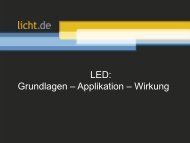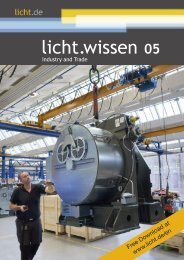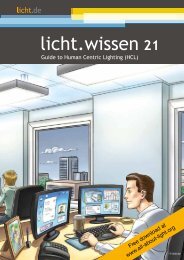licht.wissen No. 16 “City Marketing with Light“
City marketing with light offers the unique opportunity to create effects that are just not possible during the daytime and to enhance the attractiveness of public areas. Booklet No. 16 informs about city marketing and for example special informations about the LED technology.
City marketing with light offers the unique opportunity to create effects that are just not possible during the daytime and to enhance the attractiveness of public areas. Booklet No. 16 informs about city marketing and for example special informations about the LED technology.
Create successful ePaper yourself
Turn your PDF publications into a flip-book with our unique Google optimized e-Paper software.
<strong>licht</strong>.<strong>wissen</strong> <strong>16</strong> City <strong>Marketing</strong> <strong>with</strong> Light<br />
Lighting special: Energy efficiency and ErP<br />
Looking to the future and energy efficiency are topics that are influencing local authorities these days. For this<br />
reason, lighting concepts are called for that are based on innovative light sources and efficient luminaires, integrated<br />
into intelligent control systems.<br />
Towns and communities make a significant<br />
contribution to climate protection as<br />
energy efficiency has become a central<br />
aspect <strong>with</strong> city marketing <strong>with</strong> light. Authorities'<br />
lighting concepts are increasingly<br />
measured according to how they address<br />
the potential for the reduction of energy<br />
consumption. This isn't just a question of<br />
reducing the level of the lighting or abdication<br />
of light quality. Much more it is to do<br />
<strong>with</strong> harmonising the needs of the people<br />
in terms of visual comfort and safety <strong>with</strong><br />
ecological and economic demands. Innovative<br />
lighting solutions in combination <strong>with</strong><br />
intelligent control systems are the answer<br />
to this delicate balancing act.<br />
Wide-ranging benefits result from such<br />
lighting concepts:<br />
▪ Shaping the profile of the communities<br />
through attractive light designs<br />
▪ Improved light quality for the good of the<br />
citizens and for increased safety<br />
▪ An image-plus through commitment to<br />
sustainable energy-efficient products<br />
▪ Reducing the load on the environment<br />
through significantly reduced energy consumption<br />
and reduction of CO 2<br />
emissions<br />
EU regulation 245/2009 will have a large<br />
effect in this area and clear the way for<br />
energy efficiency.<br />
Energy-saving potential - road lighting<br />
Communities can reduce their energy<br />
consumption by up to 70% by deploying<br />
new road lighting equipment. These possible<br />
savings result from an improvement<br />
in the lamps, operating devices and<br />
luminaires. LED lights can even make<br />
savings of up to 80% possible. However,<br />
the suitable photometric equivalent is<br />
not yet available for each application.<br />
But, through the progress that is being<br />
made in LED technology, further application<br />
areas will soon be catered for.<br />
12<br />
Such energy saving measures are not<br />
just brought about because of a desire to<br />
protect the climate or because of statutory<br />
guidelines. Also spiralling energy prices<br />
and reduced budgetary resources are<br />
forcing towns and communities to act.<br />
Energy consumption can be reduced by<br />
up to 80% <strong>with</strong> new lighting technologies<br />
while at the same time delivering significantly<br />
increased light quality. Thus, the<br />
eco-design guidelines also have relevance<br />
for lighting in the public domain, as in the<br />
last years, road lighting has developed<br />
to become a design element in the urban<br />
space. This has increased the number<br />
of lighting points and the energy requirements.<br />
In addition, existing equipment is<br />
based on outdated, inefficient technology<br />
both in terms of the deployed operating<br />
devices and the lamps themselves. The<br />
* High-pressure sodium vapour lamp or metal halide lamp<br />
** High-pressure sodium vapour lamp or metal halide lamp <strong>with</strong> control system and<br />
50% power for 2,000 hours<br />
*** With control system and 50% power for 2,000 hours<br />
Statutory requirements<br />
Almost 20% of global power consumption<br />
is used for lighting. And as a result, introducing<br />
energy-efficiency into the lighting<br />
market has become a high priority for the<br />
European Union. The principal instrument<br />
of EU legislation in this area is the EU<br />
framework directive 2009/125/EU (ErP),<br />
introduced on 20th <strong>No</strong>vember 2009,<br />
which, as the successor to the original<br />
eco-design Guideline 2005/32/EGU(EuP),<br />
focuses on the eco-design of "energy<br />
consumption relevant" products. The<br />
minimum requirements for non-directional

















